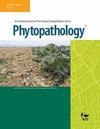Saskia Desiree Mesquida-Pesci, Abraham Morales-Cruz, Silvia Rodriguez-Pires, Rosa Figueroa-Balderas, Christian James Silva, Adrian Sbodio, Elia Gutierrez-Baeza, Petros Martin Raygoza, Dario Cantu, Barbara Blanco-Ulate
求助PDF
{"title":"根瘤菌(Rhizopus stolonifer)在引起成熟水果软腐病时表现出坏死性。","authors":"Saskia Desiree Mesquida-Pesci, Abraham Morales-Cruz, Silvia Rodriguez-Pires, Rosa Figueroa-Balderas, Christian James Silva, Adrian Sbodio, Elia Gutierrez-Baeza, Petros Martin Raygoza, Dario Cantu, Barbara Blanco-Ulate","doi":"10.1094/PHYTO-03-24-0081-R","DOIUrl":null,"url":null,"abstract":"<p><p><i>Rhizopus stolonifer</i> is known for causing soft rot in fruits and vegetables during postharvest. Although it has traditionally been considered a saprophyte, it appears to behave more like a necrotrophic pathogen. In this study, we propose that <i>R</i>. <i>stolonifer</i> invades host tissues by actively killing host cells and overcoming the host defense mechanisms, as opposed to growing saprophytically on decaying plant matter. We tested this hypothesis by characterizing <i>R</i>. <i>stolonifer</i> infection strategies when infecting four fruit hosts (tomato, grape, strawberry, and plum). We started by generating a high-quality genome assembly for <i>R</i>. <i>stolonifer</i> using PacBio sequencing. This led to a genome size of 45.02 Mb, an N50 of 2.87 Mb, and 12,644 predicted loci with protein-coding genes. Next, we performed a transcriptomic analysis to identify genes that <i>R</i>. <i>stolonifer</i> preferentially uses when growing in fruit versus culture media. We categorized these infection-related genes into clusters according to their expression patterns during the interaction with the host. Based on the expression data, we determined that <i>R</i>. <i>stolonifer</i> has a core infection toolbox consisting of strategies typical of necrotrophs, which includes a set of 33 oxidoreductases, 7 proteases, and 4 cell wall-degrading enzymes to facilitate tissue breakdown and maceration across various hosts. This study provides new genomic resources for <i>R</i>. <i>stolonifer</i> and advances the knowledge of <i>Rhizopus</i>-fruit interactions, which can assist in formulating effective and sustainable integrated pest management approaches for soft rot prevention. [Formula: see text] Copyright © 2025 The Author(s). This is an open access article distributed under the CC BY 4.0 International license.</p>","PeriodicalId":20410,"journal":{"name":"Phytopathology","volume":" ","pages":"306-315"},"PeriodicalIF":2.6000,"publicationDate":"2025-03-01","publicationTypes":"Journal Article","fieldsOfStudy":null,"isOpenAccess":false,"openAccessPdf":"","citationCount":"0","resultStr":"{\"title\":\"<i>Rhizopus stolonifer</i> Exhibits Necrotrophic Behavior when Causing Soft Rot in Ripe Fruit.\",\"authors\":\"Saskia Desiree Mesquida-Pesci, Abraham Morales-Cruz, Silvia Rodriguez-Pires, Rosa Figueroa-Balderas, Christian James Silva, Adrian Sbodio, Elia Gutierrez-Baeza, Petros Martin Raygoza, Dario Cantu, Barbara Blanco-Ulate\",\"doi\":\"10.1094/PHYTO-03-24-0081-R\",\"DOIUrl\":null,\"url\":null,\"abstract\":\"<p><p><i>Rhizopus stolonifer</i> is known for causing soft rot in fruits and vegetables during postharvest. Although it has traditionally been considered a saprophyte, it appears to behave more like a necrotrophic pathogen. In this study, we propose that <i>R</i>. <i>stolonifer</i> invades host tissues by actively killing host cells and overcoming the host defense mechanisms, as opposed to growing saprophytically on decaying plant matter. We tested this hypothesis by characterizing <i>R</i>. <i>stolonifer</i> infection strategies when infecting four fruit hosts (tomato, grape, strawberry, and plum). We started by generating a high-quality genome assembly for <i>R</i>. <i>stolonifer</i> using PacBio sequencing. This led to a genome size of 45.02 Mb, an N50 of 2.87 Mb, and 12,644 predicted loci with protein-coding genes. Next, we performed a transcriptomic analysis to identify genes that <i>R</i>. <i>stolonifer</i> preferentially uses when growing in fruit versus culture media. We categorized these infection-related genes into clusters according to their expression patterns during the interaction with the host. Based on the expression data, we determined that <i>R</i>. <i>stolonifer</i> has a core infection toolbox consisting of strategies typical of necrotrophs, which includes a set of 33 oxidoreductases, 7 proteases, and 4 cell wall-degrading enzymes to facilitate tissue breakdown and maceration across various hosts. This study provides new genomic resources for <i>R</i>. <i>stolonifer</i> and advances the knowledge of <i>Rhizopus</i>-fruit interactions, which can assist in formulating effective and sustainable integrated pest management approaches for soft rot prevention. [Formula: see text] Copyright © 2025 The Author(s). This is an open access article distributed under the CC BY 4.0 International license.</p>\",\"PeriodicalId\":20410,\"journal\":{\"name\":\"Phytopathology\",\"volume\":\" \",\"pages\":\"306-315\"},\"PeriodicalIF\":2.6000,\"publicationDate\":\"2025-03-01\",\"publicationTypes\":\"Journal Article\",\"fieldsOfStudy\":null,\"isOpenAccess\":false,\"openAccessPdf\":\"\",\"citationCount\":\"0\",\"resultStr\":null,\"platform\":\"Semanticscholar\",\"paperid\":null,\"PeriodicalName\":\"Phytopathology\",\"FirstCategoryId\":\"97\",\"ListUrlMain\":\"https://doi.org/10.1094/PHYTO-03-24-0081-R\",\"RegionNum\":2,\"RegionCategory\":\"农林科学\",\"ArticlePicture\":[],\"TitleCN\":null,\"AbstractTextCN\":null,\"PMCID\":null,\"EPubDate\":\"2025/3/20 0:00:00\",\"PubModel\":\"Epub\",\"JCR\":\"Q2\",\"JCRName\":\"PLANT SCIENCES\",\"Score\":null,\"Total\":0}","platform":"Semanticscholar","paperid":null,"PeriodicalName":"Phytopathology","FirstCategoryId":"97","ListUrlMain":"https://doi.org/10.1094/PHYTO-03-24-0081-R","RegionNum":2,"RegionCategory":"农林科学","ArticlePicture":[],"TitleCN":null,"AbstractTextCN":null,"PMCID":null,"EPubDate":"2025/3/20 0:00:00","PubModel":"Epub","JCR":"Q2","JCRName":"PLANT SCIENCES","Score":null,"Total":0}
引用次数: 0
引用
批量引用

 求助内容:
求助内容: 应助结果提醒方式:
应助结果提醒方式:


